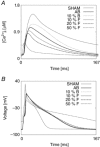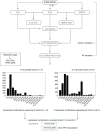Compensatory and decompensatory alterations in cardiomyocyte Ca2+ dynamics in hearts with diastolic dysfunction following aortic banding
- PMID: 28542952
- PMCID: PMC5471387
- DOI: 10.1113/JP273879
Compensatory and decompensatory alterations in cardiomyocyte Ca2+ dynamics in hearts with diastolic dysfunction following aortic banding
Abstract
Key points: At the cellular level cardiac hypertrophy causes remodelling, leading to changes in ionic channel, pump and exchanger densities and kinetics. Previous studies have focused on quantifying changes in channels, pumps and exchangers without quantitatively linking these changes with emergent cellular scale functionality. Two biophysical cardiac cell models were created, parameterized and validated and are able to simulate electrophysiology and calcium dynamics in myocytes from control sham operated rats and aortic-banded rats exhibiting diastolic dysfunction. The contribution of each ionic pathway to the calcium kinetics was calculated, identifying the L-type Ca2+ channel and sarco/endoplasmic reticulum Ca2+ ATPase as the principal regulators of systolic and diastolic Ca2+ , respectively. Results show that the ability to dynamically change systolic Ca2+ , through changes in expression of key Ca2+ modelling protein densities, is drastically reduced following the aortic banding procedure; however the cells are able to compensate Ca2+ homeostasis in an efficient way to minimize systolic dysfunction.
Abstract: Elevated left ventricular afterload leads to myocardial hypertrophy, diastolic dysfunction, cellular remodelling and compromised calcium dynamics. At the cellular scale this remodelling of the ionic channels, pumps and exchangers gives rise to changes in the Ca2+ transient. However, the relative roles of the underlying subcellular processes and the positive or negative impact of each remodelling mechanism are not fully understood. Biophysical cardiac cell models were created to simulate electrophysiology and calcium dynamics in myocytes from control rats (SHAM) and aortic-banded rats exhibiting diastolic dysfunction. The model parameters and framework were validated and the fitted parameters demonstrated to be unique for explaining our experimental data. The contribution of each ionic pathway to the calcium kinetics was calculated, identifying the L-type Ca2+ channel (LCC) and the sarco/endoplasmic reticulum Ca2+ -ATPase (SERCA) as the principal regulators of systolic and diastolic Ca2+ , respectively. In the aortic banding model, the sensitivity of systolic Ca2+ to LCC density and diastolic Ca2+ to SERCA density decreased by 16-fold and increased by 23%, respectively, relative to the SHAM model. The energy cost of ionic homeostasis is maintained across the two models. The models predict that changes in ionic pathway densities in compensated aortic banding rats maintain Ca2+ function and efficiency. The ability to dynamically alter systolic function is significantly diminished, while the capacity to maintain diastolic Ca2+ is moderately increased.
Keywords: calcium dynamics; cardiac electrophysiology; cell biology; computational modelling; diastolic dysfunction; gene expression; hypertrophy; rat.
© 2017 The Authors. The Journal of Physiology published by John Wiley & Sons Ltd on behalf of The Physiological Society.
Figures
















Similar articles
-
Calcium dynamics in the ventricular myocytes of SERCA2 knockout mice: A modeling study.Biophys J. 2011 Jan 19;100(2):322-31. doi: 10.1016/j.bpj.2010.11.048. Biophys J. 2011. PMID: 21244828 Free PMC article.
-
Rho-kinase inhibition reverses impaired Ca2+ handling and associated left ventricular dysfunction in pressure overload-induced cardiac hypertrophy.Cell Calcium. 2017 Nov;67:81-90. doi: 10.1016/j.ceca.2017.09.002. Epub 2017 Sep 9. Cell Calcium. 2017. PMID: 29029794
-
Mechanisms of impaired calcium handling underlying subclinical diastolic dysfunction in diabetes.Am J Physiol Regul Integr Comp Physiol. 2007 Nov;293(5):R1787-97. doi: 10.1152/ajpregu.00059.2007. Epub 2007 Aug 29. Am J Physiol Regul Integr Comp Physiol. 2007. PMID: 17761517 Free PMC article.
-
Calcium-regulated transcriptional pathways in the normal and pathologic heart.IUBMB Life. 2011 Oct;63(10):847-55. doi: 10.1002/iub.545. Epub 2011 Sep 7. IUBMB Life. 2011. PMID: 21901815 Review.
-
Calcium Homeostasis in Ventricular Myocytes of Diabetic Cardiomyopathy.J Diabetes Res. 2020 Nov 13;2020:1942086. doi: 10.1155/2020/1942086. eCollection 2020. J Diabetes Res. 2020. PMID: 33274235 Free PMC article. Review.
Cited by
-
In silico identification of potential calcium dynamics and sarcomere targets for recovering left ventricular function in rat heart failure with preserved ejection fraction.PLoS Comput Biol. 2021 Dec 6;17(12):e1009646. doi: 10.1371/journal.pcbi.1009646. eCollection 2021 Dec. PLoS Comput Biol. 2021. PMID: 34871310 Free PMC article.
-
Predicting left ventricular contractile function via Gaussian process emulation in aortic-banded rats.Philos Trans A Math Phys Eng Sci. 2020 Jun 12;378(2173):20190334. doi: 10.1098/rsta.2019.0334. Epub 2020 May 25. Philos Trans A Math Phys Eng Sci. 2020. PMID: 32448071 Free PMC article.
-
CD14, CD163, and CCR1 are involved in heart and blood communication in ischemic cardiac diseases.J Int Med Res. 2020 Sep;48(9):300060520951649. doi: 10.1177/0300060520951649. J Int Med Res. 2020. PMID: 32967511 Free PMC article.
-
Deterministic and Stochastic Cellular Mechanisms Contributing to Carbon Monoxide Induced Ventricular Arrhythmias.Front Pharmacol. 2021 Apr 28;12:651050. doi: 10.3389/fphar.2021.651050. eCollection 2021. Front Pharmacol. 2021. PMID: 33995065 Free PMC article.
-
Critical Requirements for the Initiation of a Cardiac Arrhythmia in Rat Ventricle: How Many Myocytes?Cells. 2022 Jun 9;11(12):1878. doi: 10.3390/cells11121878. Cells. 2022. PMID: 35741007 Free PMC article.
References
-
- Aeschbacher BC, Hutter D, Fuhrer J, Weidmann P, Delacrétaz E & Allemann Y (2001). Diastolic dysfunction precedes myocardial hypertrophy in the development of hypertension. Am J Hypertens 14, 106–113. - PubMed
-
- Amin AS, Tan HL & Wilde AAM (2010). Cardiac ion channels in health and disease. Hear Rhythm 7, 117–126. - PubMed
-
- Bailey BA & Houser SR (1992). Calcium transients in feline left ventricular myocytes with hypertrophy induced by slow progressive pressure overload. J Mol Cell Cardiol 24, 365–373. - PubMed
-
- Balke CW & Shorofsky SR (1998). Alterations in calcium handling in cardiac hypertrophy and heart failure. Cardiovasc Res 37, 290–299. - PubMed
Publication types
MeSH terms
Substances
LinkOut - more resources
Full Text Sources
Other Literature Sources
Miscellaneous

